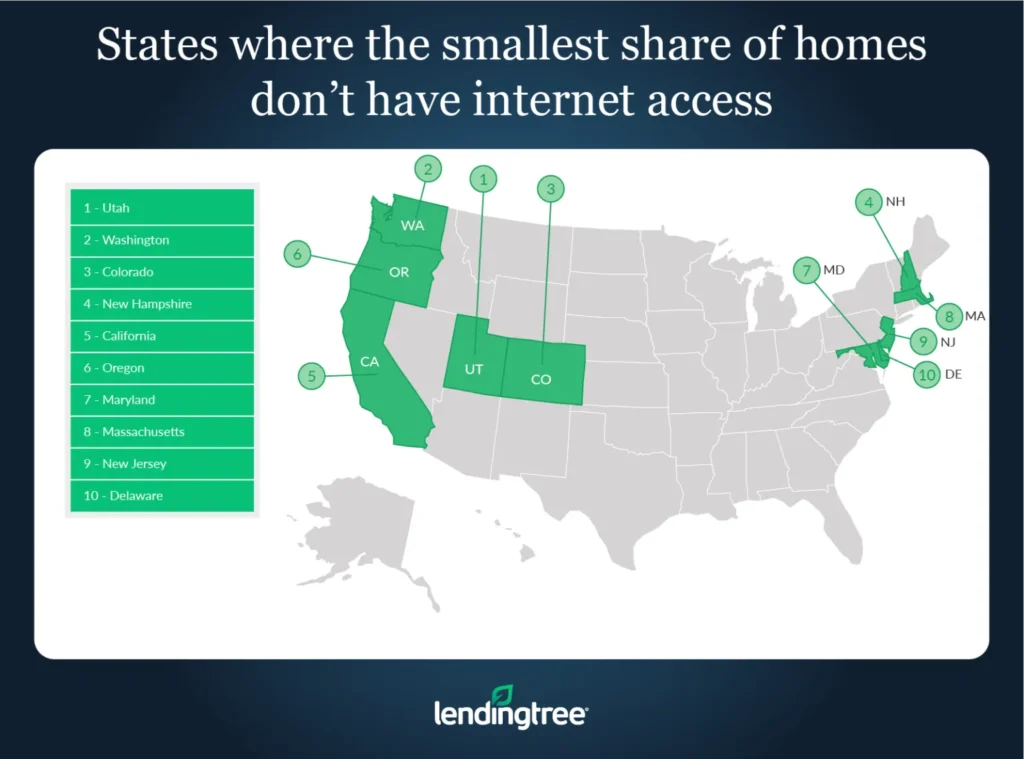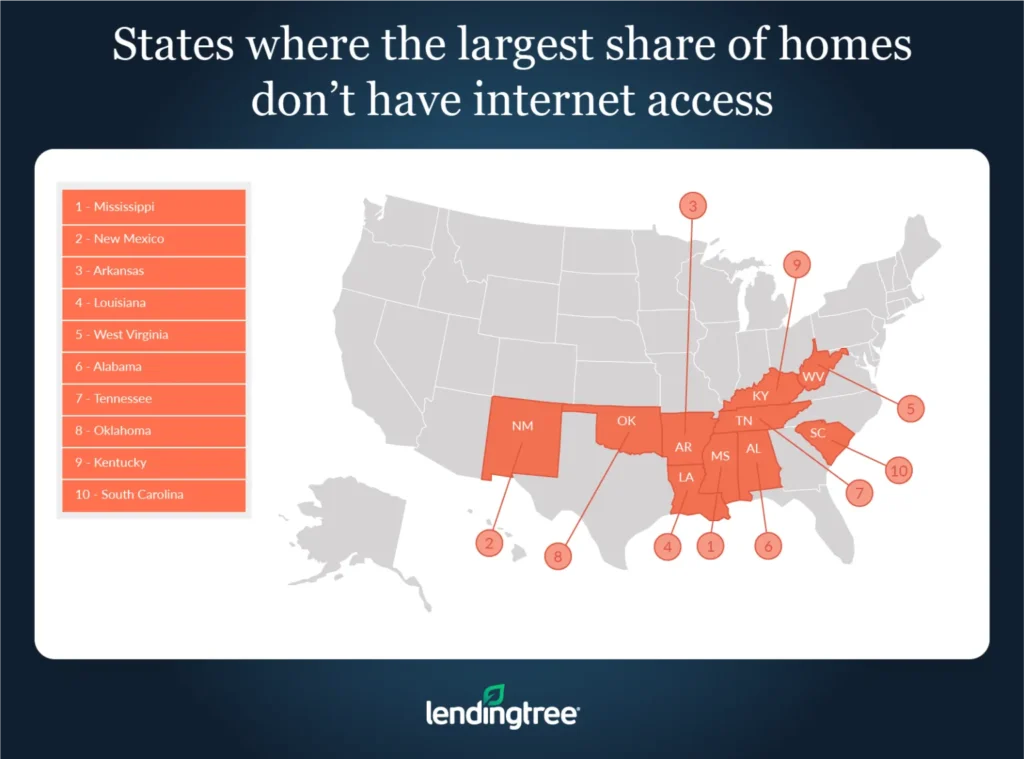More Than 14 Million Households Across U.S. Don’t Have Internet
In 1983, 1.4% of U.S. adults reported using the internet in their homes. Today, nearly 86% of U.S. households have some type of internet subscription.
This highlights how at-home internet services have gone from a novelty to a necessity over the past nearly 40 years. And though it’s an undeniably important part of modern life, many households across the U.S. lack internet access.
To get a sense of how many households don’t have access, LendingTree analyzed data from the U.S. Census Bureau’s 2020 American Community Survey to compare the share of internet-connected households to the share of non-connected households in each of the nation’s 50 states.
Ultimately, we found more than 14.4 million households across the U.S. don’t have internet access.
Key findings
- An average of 12.22% of households across the nation’s 50 states don’t have internet access. While some homes may not have access because occupants don’t want internet service, others may not because they can’t afford it or because there are no providers in their area.
- Utah, Washington and Colorado have the smallest share of homes without internet access. Across these states, 7.17% of households aren’t connected to the internet.
- Mississippi, New Mexico and Arkansas have the largest share of homes without internet access. In these states, an average of 19.17% of households don’t have internet.
- More rural states typically have larger shares of households without the internet compared to more urban states. For example, the three states with the largest share of homes without internet access — Mississippi, New Mexico and Arkansas — are considered relatively rural, meaning that their populations are less densely packed together. That said, some states considered more urban have a significant share of households that lack internet. In relatively urban Pennsylvania, for instance, 13.24% of households don’t have internet access — higher than the 50-state average of 12.22%.
- An average of 72.44% of the nation’s more than 100 million internet-connected households have more than one type of subscription. Having access to more than one type of internet subscription — like wired broadband and a cellphone plan with high-speed access — can be beneficial as it can give households more options to connect should their typical method become unavailable.
States where the smallest share of homes don’t have internet access
1. Utah
- Total number of households: 1,003,345
- Percentage of households with internet access: 93.60%
- Percentage of households without internet access: 6.40%
2. Washington
- Total number of households: 2,905,822
- Percentage of households with internet access: 92.66%
- Percentage of households without internet access: 7.34%
3. Colorado
- Total number of households: 2,137,402
- Percentage of households with internet access: 92.24%
- Percentage of households without internet access: 7.76%

States where the largest share of homes don’t have internet access
1. Mississippi
- Total number of households: 1,116,649
- Percentage of households with internet access: 79.27%
- Percentage of households without internet access: 20.73%
2. New Mexico
- Total number of households: 792,755
- Percentage of households with internet access: 81.53%
- Percentage of households without internet access: 18.47%
3. Arkansas
- Total number of households: 1,170,544
- Percentage of households with internet access: 81.70%
- Percentage of households without internet access: 18.30%

Tips for making sure your new home has internet access
It may seem like a given that you’ll easily be able to get internet access in your next house. But, as our study shows, there are plenty of homes across the country without internet access. Here are three tips you should keep in mind before you buy a house to be sure you’ll be able to connect to the web from your new home.
- Check internet coverage before you make an offer. When you’re house hunting, be sure any property you’re considering buying is in an area where internet subscriptions are available. You can call local internet service providers (ISPs) and ask who provides coverage at your potential new address. You should also ask about what speeds a potential service provider can provide. Checking connectivity is especially important if high home prices have made you consider buying a cheaper home in a more rural area.
- Be sure you’ll have permission to change your internet hookup. In some instances, you might want to subscribe to an ISP that needs to install additional hardware or components like a satellite dish or fiber-optic cables. Be sure those kinds of installations wouldn’t violate the rules of any city ordinances and/or your homeowners association. Otherwise, you may find you’re not allowed access to the type of internet you prefer.
- Don’t forget to factor in internet costs before you buy. Internet access usually isn’t free, so you should be sure that the monthly mortgage payment on the home you’re planning to buy wouldn’t leave you without any extra money for house amenities. While it might seem obvious to budget for these extra costs, it’s possible to get distracted in the house hunting and homebuying process.
If your household is struggling financially to afford internet service, you may be able to utilize the federal Affordable Connectivity Program (ACP). Under this program, qualifying households can receive a monthly $30 discount on their internet bills. There may also be programs available at the local and state levels. If you can connect to the internet, check your local and state government websites for more details.
Methodology
LendingTree analyzed the U.S. Census Bureau’s 2020 American Community Survey with five-year estimates (the latest available at this study’s writing) to rank the nation’s 50 states by the share of households with some type of at-home internet access.
Specifically, the LendingTree ranking included households with subscription access to at least one of the following internet services at their home:
- Dial-up
- Cellphone
- Broadband (high speed) cable, fiber optic or DSL
- Satellite
- Some other type*
- Access without a subscription**
*The Census Bureau doesn’t list the types of internet subscriptions that may fall under this category. They do note that the American Community Survey is based on self-reported data, so it’s possible that some types of internet classified as “other” could fit into one of the above categories.
**Those with access to the internet without a subscription can include people who live in towns, cities or other areas that provide free internet services to residents.
View mortgage loan offers from up to 5 lenders in minutes
Read more
Selling and Buying a House at the Same Time: How It Works Updated February 6, 2025 Real estate markets are still extremely competitive. To move quickly, you might plan to buy…Read more
How Home Construction Loans Work Updated December 6, 2023 Can’t afford to pay cash to build a new home? Here’s everything you need to…Read more

